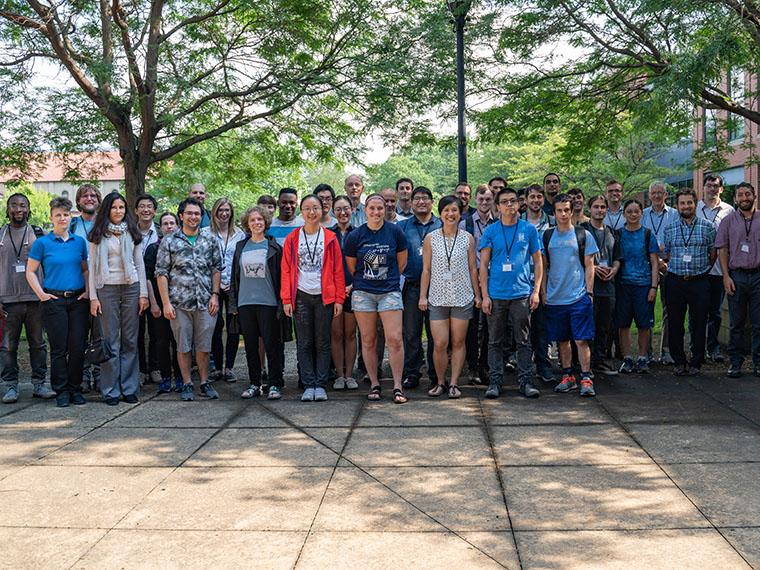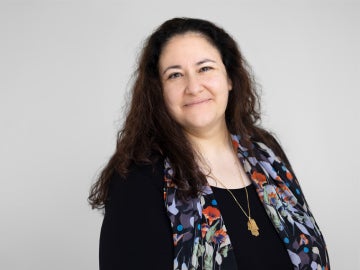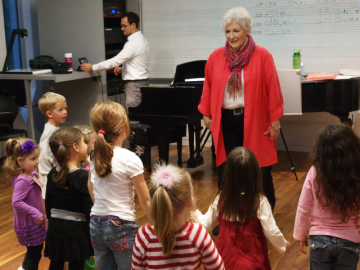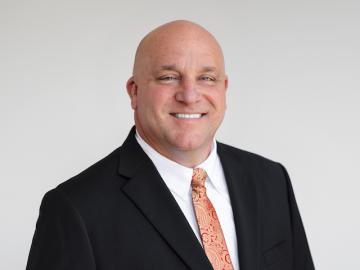Campus News
Q&A with Chris Marx: Great Lakes Mathematical Physics Meeting
July 12, 2019
Communications Staff

Great Lakes Mathematical Physics meeting attendees pose together on the Oberlin College campus.
Photo credit: Sylvia Rios
Assistant Professor of Mathematics Chris Marx served as the local organizer of the Great Lakes Mathematical Physics meeting (GLaMP) held June 28-30, 2019 at Oberlin College. For the first time in the program’s history, undergraduate students, including six from Oberlin, were able to participate.
Q: The Great Lakes Mathematical Physics meeting is an annual meeting in mathematical physics in the greater Midwest. How did Oberlin College come to host this meeting?
Since the first GLaMP meeting four years ago, the conference has been co-organized by Michigan State University (MSU), the University of Kentucky (UKY), and Oberlin College. The first three meetings were held at MSU; starting with this year’s meeting the plan is to alternate the meeting between MSU, UKY, and Oberlin. I was excited to host this year’s meeting on our campus and, for the first time, open up participation to also include undergraduate students.
Aside from logistics, my primary responsibility as a local organizer was to secure funding. This year, we were fortunate to receive support from four organizations, which awarded funding totaling $35,700: the National Science Foundation (NSF, DMS-1900167; $30,000), the Institute for Mathematics and its Applications (IMA), the American Institute of Physics (AIP), and the International Association of Mathematical Physics (IAMP). The meeting was also awarded “in cooperation status” by the Association for Women in Mathematics (AWM).
Q: How would you describe "mathematical physics"?
Generally speaking, mathematical physicists aim to provide a mathematically rigorous foundation of physics. This means to develop a mathematically sound and consistent framework, which allows to prove theorems that capture the behavior of physical systems. In the United States, most mathematical physicists are employed in mathematics departments. Current research interests include statistical physics, quantum mechanics, many body and solid state physics, and general relativity. With our conference, we try to represent the field as broadly as possible.
Q: What was the overall goal of GLaMP, and how was it achieved?
The distinguishing feature of the GLaMP meeting has been its emphasis on young researchers in the field. With the majority of contributed talks given by early-career faculty, postdocs, and graduate students, we aim to provide a forum that showcases the work of young researchers, offers career development opportunities, and more generally, helps secure a flourishing future of mathematical physics in the United States.
Q: Part of GLaMP's special focus is the support of young researchers in the field. How was that group supported?
The GLaMP meeting offers career development opportunities, specifically through a three-hour mini course in a topic of current research interest by a world-class expert, four invited plenary talks from leading researchers in their respective fields, and a career round table, representing different career paths in mathematical physics, both in academia and in industry. This year’s mini course was on “disordered quantum spin chains” given by Günter Stolz of the University of Alabama, Birmingham. The career round table advises students and junior researchers on career issues in mathematical physics and related areas.
Q: Six Oberlin students participated in the GLaMP—this was the first time undergraduate students were able to attend the meeting. How were these undergraduates involved?
One intention in opening the meeting to undergraduate students was to give them the opportunity to experience a research conference and see examples of the type of problems that people are currently interested in. In addition, participating undergraduate students also had a chance to interact with current graduate students, post-docs, and junior researchers, i.e. participants who are only one or two career steps removed from them. In conjunction with the career round table, we hoped this would give undergraduate students useful insights and examples which would help them in their own career planning.
We were pleased that seven of the 43 registered participants of GLaMP 2019 were undergraduate students, six of whom were affiliated with Oberlin: Didi Banyeretse, Alexandra Du, Rainie Heck, Omar Hurtado, Claire Segura, and Hengrui Zhu.
Q: Is there anything else you'd like to share about the GLaMP?
The feedback we received by the participants was phenomenal. In this context, I am very grateful for the local support, in particular from Oberlin’s Conference Services and the staff of the Hotel at Oberlin, both of which made this meeting run as smoothly as it did. With this year’s successful meeting, I am already looking forward to GLaMP 2020 which, I am happy to report, will again take place at Oberlin.
You may also like…
Remembering Former Visiting Assistant Professor Leila Ben-Nasr
Leila Ben-Nasr, a former visiting assistant professor of comparative American studies, died on November 28, 2025.
Oberlin Community Remembers a Beloved Retired Professor
A member of Oberlin faculty for 13 years, Peggy Bennett was known by students and the Oberlin community for creating and leading MusicPlay, a preschool classroom and learning lab run as part of the...
Eric Rooks Named Director of Campus Safety at Oberlin
Longtime public servant emphasizes collaborative partnerships and kindness.


